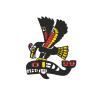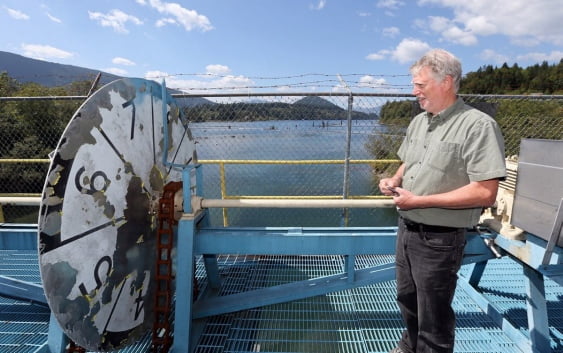 Amy Smart, Times Colonist, August 30 2015
Amy Smart, Times Colonist, August 30 2015
Aquatic life suffering as water levels fall below amounts needed to sustain it
Joe Saysell stands at the edge of his Cowichan River property, searching the shallow water with no luck.
Apart from a stray claw shell, there’s no sign of crayfish, a typically abundant food source for everything from heron to trout.
“Our crayfish are dying,” he says, dipping a finger in the water.
“It’s like soup.”
During a recent cleanup of the river, Saysell says, volunteers counted three dozen crayfish where there are normally many more. Six were alive, 30 were dead.
Stewards of the river say it’s just one symptom of climate change and extreme drought this season. In the past month on the Cowichan River, water temperatures have risen to 24 C, river levels have dropped and a roundtable has voted to reduce the flow to 4.7 cubic metres per second in an effort to make it last longer — a significant drop from the recommended summer minimum of seven cubic metres per second. With little or no rainfall, the river is projected to begin drying up at the end of September.
The frustrating part, from Saysell’s perspective: It doesn’t have to be this way.
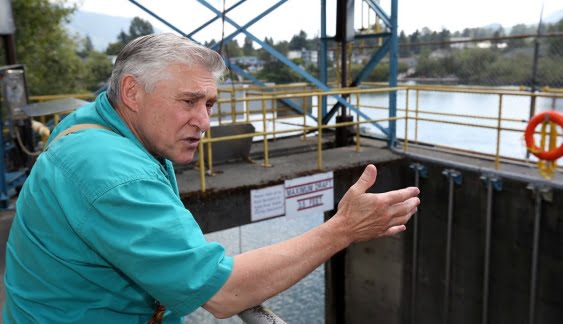 “The province is burning up everywhere, there’s talk about rivers drying up all over the place. Most of B.C. is closed for fishing. But this never needed to happen. This is one part of the province where we didn’t have to go through this. All the others did, because they’re not lucky enough to have a lake and they’re not lucky enough to have a weir.”
“The province is burning up everywhere, there’s talk about rivers drying up all over the place. Most of B.C. is closed for fishing. But this never needed to happen. This is one part of the province where we didn’t have to go through this. All the others did, because they’re not lucky enough to have a lake and they’re not lucky enough to have a weir.”
Raising the weir at the end of Cowichan Lake was identified as a solution more than 20 years ago, Saysell says. For every one centimetre the weir is raised, the river could be bolstered by a day’s worth of flow at seven cubic metres per second.
The problem is a lack of political will from the provincial and federal governments, he says. There are also so many stakeholders that it’s unclear who should pick up the slack.
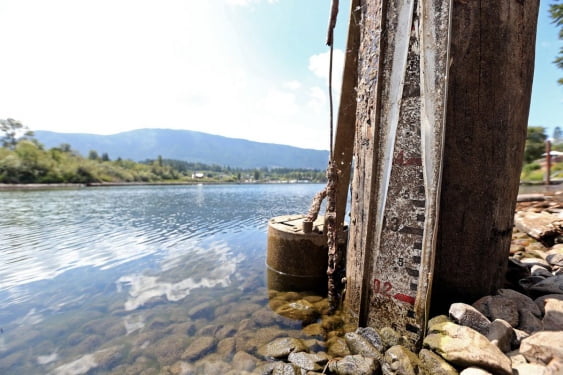 From the platform leading up to the floodgates at the head of the Cowichan River, a ladder of markers records a history of declining water levels.
From the platform leading up to the floodgates at the head of the Cowichan River, a ladder of markers records a history of declining water levels.
At the top: A line labelled 1968 marks a year of abnormally high water and flooding. Several feet below that, 2005. And well below that, a stream runs through the gate.
Lower precipitation rates, higher temperatures and less snowpack have meant average inflows dropped by 36 per cent between the 1980s and 2010, stewards say.
As drought conditions continue, pressure is rising to balance conflicting needs. They range from the 600 employees at Catalyst Paper — a Crofton pulp and paper mill that depends on the flow for operations — to recreational tubers and wastewater-treatment managers, who depend on the river to dilute sewage outfall.
Cowichan Tribes associate biologist Tim Kulchyski says chinook salmon are among the species most vulnerable to the water-level and flow-rate drop. And the implications are far-reaching.
“For us, for Cowichan, this is an extremely sensitive personal issue. And a huge part of our history on the Cowichan River for thousands of years was heavily influenced by these stocks,” Kulchyski says.
Kulchyski caught his first chinook on the river at age eight or nine. He says the way the community responds to the crisis will set the tone for future challenges.
“It’s a reflection to people like myself — it’s a reflection of our own existence. If we don’t handle things like this, how will we handle greater issues in the future?” he says.
Unlike many other communities, the Cowichan Valley has developed a co-operative process for negotiating the balance. A mix of about 40 officials and volunteers meet monthly at the Cowichan Stewardship Roundtable. There are also a surprising number of organizations dedicated to the health of the watershed, from the Cowichan Valley Naturalists Society to the Cowichan Watershed Society.
“This broad interest has come together and recognized the importance of having a healthy watershed,” says Rodger Hunter, co-ordinator of the Cowichan Watershed Board.
At the roundtable’s most recent meeting, they made the difficult decision to reduce water flow to 4.7 cubic metres per second. It was a conservation strategy, made in the hope that it will make the water supply from Cowichan Lake last until rains replenish the source. But it came at a cost: It made it more difficult for the chinook salmon to move upstream.
Representatives from Cowichan Tribes and Fisheries and Oceans Canada had initially opposed the reduction, having already reluctantly approved a drop to 5.5 cubic metres per second.
BY THE NUMBERS
In the past month:
• 180 chinook salmon have made their spring run
• Eight sockeye have been counted in the river
• Crayfish are dying en masse
• Water temperatures have reached 24 C
• Water flow reduced to 4.7 cubic metres per second, down from 5.5 cubic metres per second. Under normal conditions, the minimum allowable flow rate is seven cubic metres per second.
Kulchyski says the decision to compromise again came with the belief the chinook salmon had mostly finished their spring run — about 180 fish had been counted in the river.
Also, this year has marked a turning point, from his perspective. Catalyst Paper, which owns and operates the weir, has invested in studies of the river covering temperature, fish counts and other factors, he says.
“We’re not happy that we’re down to 4.7,” he says. “[But] I think we’re happier that there’s stronger focus on the long term. It’s about trying to find a balance.”
Although this year has been an especially trying one, Kulchyski said he has also found it heartening, because of the commitments that have been made to monitor salmon stocks, water temperature and other health indicators. Collecting data and identifying exactly what’s changing is the first step toward fixing it.
“I’ve been quite frustrated over the years. This year, I’m feeling better that there’s now some movement and some acceptance [of the challenges]. Whether things are going to happen in a timely fashion, with some meaningful response? I’m optimistic. But there’s still a lot of things up in the air.”
Raising the weir has met several obstacles. One was a 2013 legal challenge from lakefront property owners, who feared losing land if water levels rose. The landowners challenged a provincial decision to change the rule that says how much water is released over the weir in July. The environmental appeal board ruled against them. Stewards believe it set a precedent to allow for a raising of the weir.
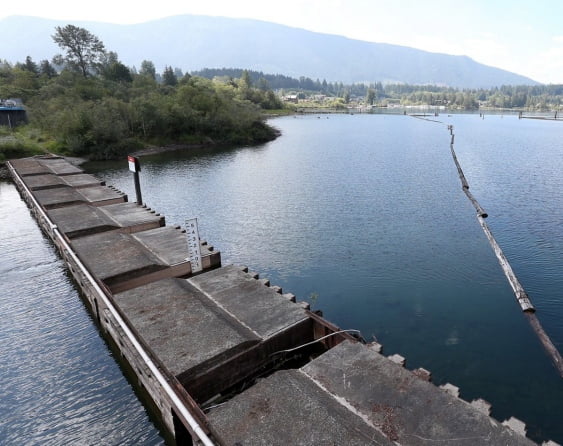 Another obstacle is cost. Jon Lefebure, chairman of the Cowichan Valley Regional District, estimates raising the weir could cost upward of $10 million. The CVRD has applied to the Gas Tax Strategic Priorities Fund for two-thirds of it, but won’t know until fall if it will be granted.
Another obstacle is cost. Jon Lefebure, chairman of the Cowichan Valley Regional District, estimates raising the weir could cost upward of $10 million. The CVRD has applied to the Gas Tax Strategic Priorities Fund for two-thirds of it, but won’t know until fall if it will be granted.
But before the weir can be raised, someone has to apply for a water licence. From most of the stakeholders’ perspectives, it should be either the provincial or federal government. The province is responsible for trout and steelhead, while the federal regime is responsible for the salmon.
“It’s about preserving a heritage river in their jurisdiction and the fish in it and the entire ecosystem. … They should take a stake in this; it’s about showing leadership, that’s what we’re appealing for,” says Parker Jefferson, director of One Cowichan.
In the meantime, community members are doing what they can to mitigate the consequences and respond to unusual changes.
In the past month, eight sockeye have appeared for the first time in 60 years, Saysell says. (Kulchyski says elders have reported anomalies like sockeye and pink in other years). And while temperatures of 24 C are lethal to many fish, stewards are studying the river to find cold-water refuges — pockets of colder water safe for salmon.
Jefferson, who is also part of the Cowichan Lake and River Stewardship Society, says volunteers have already rescued 100,000 salmon fry stranded in pools that had been cut off from the river.
“We’re close to a solution,” Jefferson says.
“There’s a sense of urgency. We know it needs to be done very soon.”
Hunter says the community has an eye on the broad goal of improving the health of the watershed, with smaller goals that include rehabilitating the riparian habitats, bringing watershed education into Grade 4 and 5 classrooms and moving the sewage outfall to a better location.
“The spirit of co-operation here in the valley probably supercedes anywhere else. People just know and care about the river,” Hunter says.
The trouble is, it’s not clear how much longer it will last.
 Email
Email